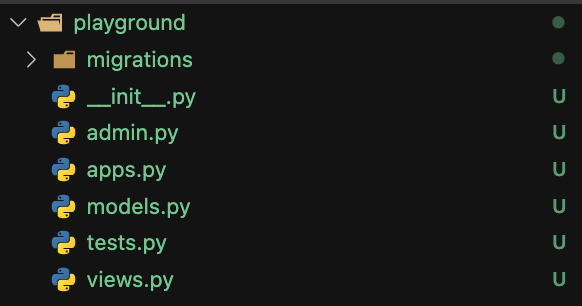This is a demo for Django framework

- admin sit
- object-relational mapper (ORM),it abstracts the database. So we can query or process data without writing a lot of SQL.
- Authentication
- Caching
This is package for javascript projects
- activate the virtual (you can do it or not). If you do it, you are gonna use the python interpreter inside this cirtual environment,not the one that globally
- Go to a directory
- run
pipenv shell
- run
django-admin startproject project_name .
- django-admin is a utility that comes with django. run it we can use all of the commands that we can use to woek with django projects
- run
django-admin runserver (portnumer). You can start a project by running this command, you can specify the port you are gonna run on your localhost.
- small tips run
lsof -i: portnumberto test if the port that you are gonna use is occupied or not, if it shows you nothing then you can use it. In following case, you cannot use 8888, but you can use 8000. 8888 is already being accupied
mac ~ lsof -i:8888 14:15:39
COMMAND PID USER FD TYPE DEVICE SIZE/OFF NODE NAME
Google 486 mac 24u IPv6 0x652da220aafaae0d 0t0 TCP localhost:52499->localhost:ddi-tcp-1 (ESTABLISHED)
Google 486 mac 25u IPv6 0x652da220d9fbe14d 0t0 TCP localhost:50389->localhost:ddi-tcp-1 (ESTABLISHED)
python3.8 18377 mac 7u IPv4 0x652da220c520a64d 0t0 TCP localhost:ddi-tcp-1 (LISTEN)
python3.8 18377 mac 8u IPv6 0x652da220e4cf47ad 0t0 TCP localhost:ddi-tcp-1 (LISTEN)
python3.8 18377 mac 13u IPv6 0x652da220d9fbf46d 0t0 TCP localhost:ddi-tcp-1->localhost:50389 (ESTABLISHED)
python3.8 18377 mac 66u IPv6 0x652da220d9fbfacd 0t0 TCP localhost:ddi-tcp-1->localhost:52499 (ESTABLISHED)
mac ~ lsof -i:8000 0.16 14:16:49
mac ~ - settings.py . This is where we defind our application settings.
- urls.py . This is where we define url applications
- asgi.py and usgi.py. They are used for deployment
- manage.py, This is the wrapper arpund django admin. It knows the setting of our project. So in the project whenever you need to run
django-admin XXX, don't run it. Instead you should runpython manage.py XXXX
1. run python manage.py startapp playground, playground is a django app. Every django app uses exactly same structure.
- migration folder is for generating database tables
- admin.py is where we define how the admin interface for this app is going to look like
- app.py(configure) .don't get fooled by the name. This is where we configure the app.
- models.py: This is where we define the model classes for this app. We use model classed to pull out data from database and present it to our user. (This is similar to every MVC framework)
- test.py 我的理解就是个写test的地方,还没有去研究
- views.py 相当于java中的request handler 就是个处理前端传过来的request的地方,返回一个response
INSTALLED_APPS = [
'django.contrib.admin',
'django.contrib.auth',
'django.contrib.contenttypes',
'django.contrib.sessions',
'django.contrib.messages',
'django.contrib.staticfiles',
'playground', # this is where we regist the app
]# Create your views here.
def say_hello(request):
# return HttpResponse("Hello, world. You're at the polls index.")
return render(request, 'html')- In playground/urls.py we add, this is in your app
from django.urls import path
from . import views
# This is where we mapping url to views so when we input a url in a browser we know where to go
urlpatterns = [
path('hello/', views.say_hello),
]- import include in the directory of your storefront, This is the rrot directory of your django project, use the parameter include
from django.urls import path, include
urlpatterns = [
path('admin/', admin.site.urls),
path('playground/',include('playground.urls'))
]minimal coupling high cohesion
